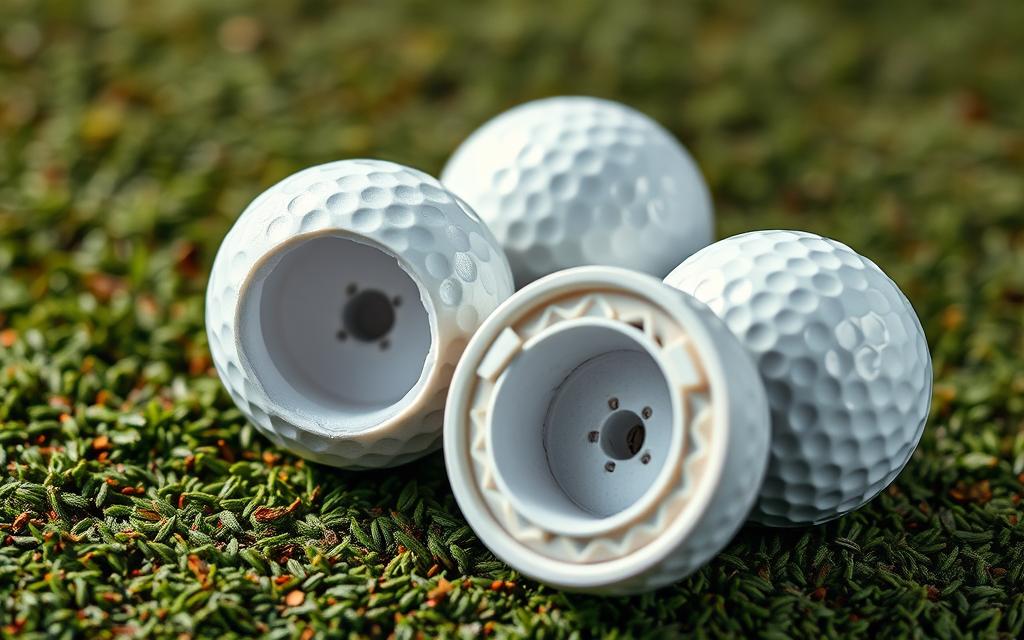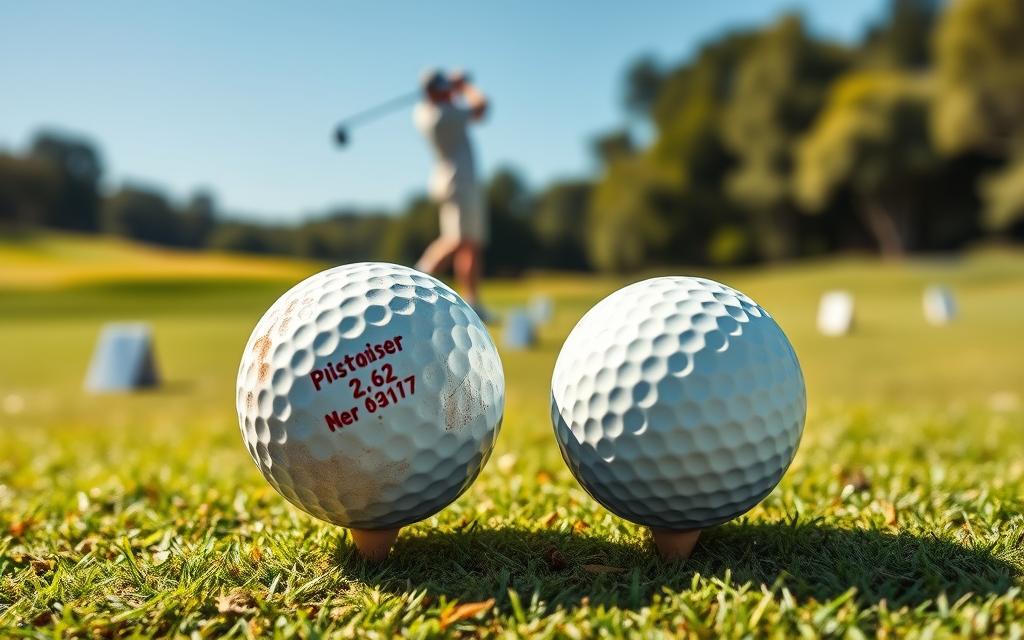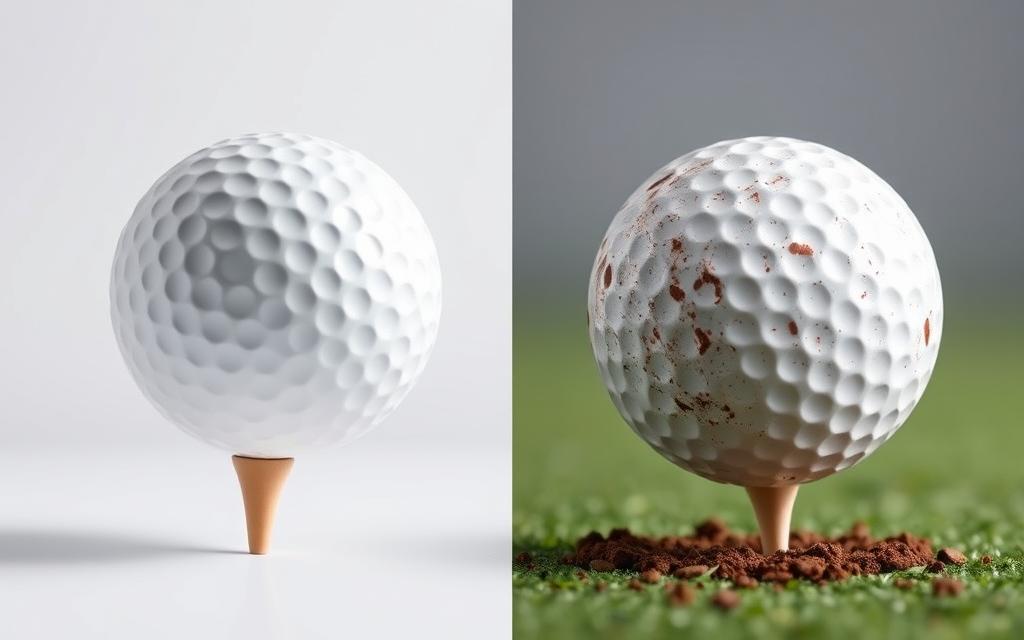Have you ever thought about how old golf balls affect your game? Many golfers wonder about this. The condition of your golf balls can really change how well you play. We’ll look at how aging affects distance and when it’s time to get new ones.
The way your golf balls perform changes as they get older. This is because the materials and construction wear out. But how much does this really affect your game? Let’s find out in this detailed guide.
Key Takeaways
- Understand the impact of golf ball age on performance and distance
- Explore the role of technology and construction in modern golf ball design
- Identify the visual and performance-based signs that it’s time to replace your golf balls
- Measure the average distance loss experienced with older golf balls
- Weigh the importance of ball quality and brand variability on your game
- Learn tips for extending the lifespan of your golf balls through proper storage and maintenance
The Impact of Golf Ball Age on Performance
Golf ball age can really affect your game. Knowing how modern golf balls are made helps you see how they change. This can impact your performance.
Understanding Golf Ball Construction
Modern golf balls use advanced materials for better spin, distance, and control. They have a core and a cover. As they age, these parts can change, affecting how they perform.
The Role of Technology in Modern Golf Balls
New tech has made golf balls better than ever. Things like dimples and special materials help with distance and feel. But, these benefits can fade as the ball gets older.
How Age Affects Compression and Feel
Age affects a golf ball’s feel and how it compresses. Used balls lose their bounce, changing how they fly. This makes them feel less lively during play.
| Characteristic | New Golf Ball | Aged Golf Ball |
|---|---|---|
| Compression | High | Reduced |
| Feel | Lively and Responsive | Dull and Less Responsive |
| Distance | Optimal | Decreased |
| Spin | Consistent | Reduced |
Knowing how golf ball aging effects and golf ball compression loss impact your game is key. By understanding golf ball degradation over time, you can choose the right time to replace them. This helps keep your game at its best.

“The key to maximizing the performance of your golf balls is understanding how they change over time and adjusting your game.”
Signs It’s Time to Replace Your Golf Balls
As a golfer, watching your golf balls closely is key. Their life span changes based on how often you play, the weather, and how you store them. Spotting when it’s time for new golf balls helps keep your game sharp and consistent.
Visual Indicators of Wear and Tear
One clear sign is when your golf balls show wear. Look for these signs:
- Fading or discoloration of the ball’s surface
- Scuffs, cuts, or indentations on the ball’s dimple pattern
- Significant loss of the ball’s original shiny finish
As golf ball dimple wear happens, the ball’s flight can suffer. This means less distance and control.
Performance Changes You Might Notice
Changes in how your golf balls perform are also telling. Watch for these signs:
- Reduced golf ball lifespan and distance off the tee
- Decreased spin and control on approach shots
- Altered feel and feedback when making contact with the ball
These changes can sneak up on you. So, it’s important to notice any small differences in your ball’s behavior.
Guidelines for Ball Replacement Frequency
There’s no single rule for when to replace your used golf balls. But here are some general tips:
- For casual golfers who play 1-2 times per week, replace balls every 6-12 months
- For avid golfers who play 3-4 times per week, replace balls every 3-6 months
- For competitive players or those who frequently practice, replace balls every 1-3 months
These are just rough guidelines. Your golf balls’ life span can differ based on your style and the courses you play.
Measuring Distance Loss with Old Golf Balls
Golf balls get worse with age, losing distance. Knowing how much and why helps golfers decide when to get new ones.
Average Distance Loss Compared to New Balls
Old golf balls can lose 5 to 15 yards compared to new ones. This loss depends on the ball’s make, the player’s swing, and how many times it’s been used.
Factors Influencing Distance Reduction
- Ball compression: Older balls lose core resilience, reducing compression and distance.
- Aerodynamics: Dimple patterns on balls can wear off, affecting lift and drag, and distance.
- Wear and tear: Damage to the ball’s cover can hurt its performance and reduce distance.
Testing with Different Ball Models
Testing different balls is key to measuring distance loss. Use launch monitors or hitting ranges to compare new and used balls. This helps golfers understand how much distance they lose with older balls.

The amount of distance lost with old golf balls varies. It depends on the golfer’s conditions and preferences. By testing their balls, players can improve their game and enjoy the course more.
The Importance of Ball Quality on Your Game
Golf ball quality greatly affects your game. It’s key to know how golf ball performance and factors affecting golf ball distance work. Whether you pick used golf balls or new ones, your choice matters a lot.
Choosing Between Premium and Standard Balls
Premium golf balls offer better distance, control, and feel. They have special materials like urethane covers. Standard balls are cheaper but work well for casual players.
How Brand Variability Affects Longevity
Each golf ball brand lasts differently. Some get worn out faster, while others last longer. Knowing this helps you choose the right balls for you.
Balancing Cost and Performance for Golfers
Choosing between premium and standard balls depends on your budget and goals. Casual players might prefer standard balls. Serious players might choose premium for better performance.
| Ball Type | Average Distance | Spin Control | Durability | Cost |
|---|---|---|---|---|
| Premium | 260-280 yards | High | Moderate | $40-$60 per dozen |
| Standard | 240-260 yards | Moderate | High | $20-$30 per dozen |
Knowing about ball quality helps you make better choices. Whether you go for premium or standard, find what fits your game best.
Tips for Extending the Life of Your Golf Balls
Buying good golf balls is important. But making them last longer can help you play better. Simple steps like storing, cleaning, and taking care of them can keep your balls in top shape.
Proper Storage Techniques
Storing your golf balls right is key. Keep them in a cool, dry spot. Stay away from sunlight and very hot or cold places.
Don’t store them in your car or garage. The changing weather can make them wear out faster. Use a special container or a place that keeps a steady temperature.
Cleaning and Maintenance Best Practices
Cleaning your golf balls often keeps them in good shape. This means they will spin, control, and go far better. After each game, gently wipe them with a soft cloth or a golf ball cleaner.
Don’t use rough stuff or strong cleaners. They can hurt the ball’s cover and make it play worse.
When to Use Old Balls in Practice vs. Play
Older golf balls don’t play as well as new ones. But they’re okay for practice. Save your best balls for when you’re playing for real.
Old balls can help you practice without worrying about how far they go. This lets you work on your game without distractions.


